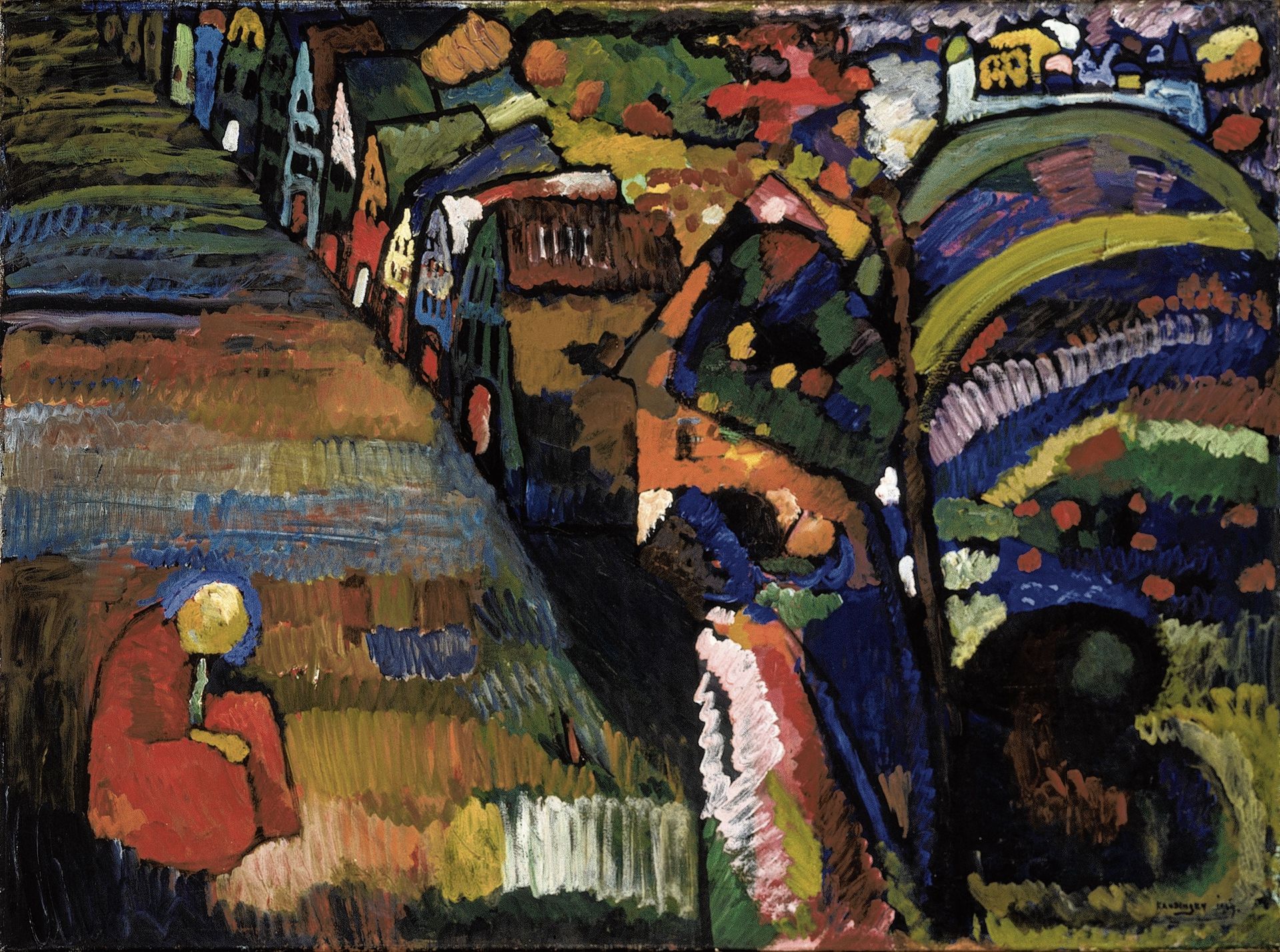News:
Bij roofkunst staat belang slachtoffer altijd voorop - With looted art the interest of the victim always comes first
De kritiek op het Nederlands roofkunstbeleid is suggestief en berust niet op feiten, schrijft Alfred Hammerstein.
(English translation below)
 Wassily Kandinsky, Bild mit Häusern, 1909.
Wassily Kandinsky, Bild mit Häusern, 1909.
Het opiniestuk van Wesley Fisher en Anne Webber, Van leider naar paria? Nederland, herzie beleid roofkunst (8/12), vraagt om een weerwoord. Het bevat op veel onderdelen een onjuiste voorstelling van zaken.
Er mag geen twijfel over bestaan dat belangen van de slachtoffers van het naziregime altijd voorop staan. De Restitutiecommissie, in 2001 in het leven geroepen om advies uit te brengen over claims op naziroofkunst in Nederlands openbaar bezit, erkent en respecteert die belangen. Kunstwerken die door of als gevolg van naziterreur aan deze slachtoffers zijn ontnomen, behoren te worden gerestitueerd. De commissie hanteert onverminderd de normen van de Nederlandse commissie-Ekkart uit 1997 en de internationaal afgesproken, zogeheten Washington Principles uit 1998 als leidraad. Op grond van deze normen neemt de Restitutiecommissie tot uitgangspunt dat een verkoop door een particulier tijdens de bezetting vanaf mei 1940 verondersteld wordt onvrijwillig te zijn geweest, behoudens bewijs van het tegendeel. Fisher en Webber bekritiseren onder meer het bindende advies van de commissie over het schilderij Bild mit Häusern door Wassily Kandinsky. Daarin is geoordeeld dat de verkoop op de veiling niet los kan worden gezien van het naziregime.
Het spreekt vanzelf dat niet ieder onvrijwillig bezitsverlies hetzelfde is. In sommige gevallen is een kunstvoorwerp letterlijk geroofd of met geweld afgenomen en in andere gevallen is sprake geweest van een transactie, die zonder de omstandigheden van de oorlog, een gewone verkoop zou zijn geweest. Daarbij is van belang of de koper te goeder trouw was. Als dat zo is, zou deze transactie naar de gewone regels van het recht niet aantastbaar zijn. De Nederlandse musea die dergelijke transacties zijn aangegaan, hebben ermee ingestemd dat de Restitutiecommissie desondanks bij bindend advies tot teruggave kan besluiten. Dat heeft zij in vele gevallen ook gedaan.
Afwegingen van de Restitutiecommissie
De commissie moet daarbij volgens het Nederlandse overheidsbeleid alle omstandigheden in haar oordeel betrekken. Als de verkoop als een onvrijwillige wordt beschouwd, kan er sprake zijn van persoonlijke omstandigheden die het waarschijnlijk maken dat de verkoop ook had plaatsgevonden zonder druk van de oorlogsomstandigheden. In het geval dat de oorspronkelijke eigenaar na de oorlog de mogelijkheid heeft gehad de transactie aan te vechten maar dat heeft nagelaten, kan dit een aanwijzing zijn dat dit zo is. Ten slotte kan de commissie in haar afweging betrekken dat de partij die het schilderij claimt, geen enkele relatie daarmee heeft gehad en (bijvoorbeeld) alleen belang heeft bij restitutie in verband met de opbrengst na verkoop.
Er kunnen (dus) omstandigheden zijn die tot de conclusie leiden dat de kunsthistorische waarde en het belang bij het behoud van een schilderij voor een Nederlandse museumcollectie zwaarder wegen dan die van de eiser in kwestie. Op enig moment kantelt de afweging in het voordeel van een museum dat, als de commissie anders had besloten, zich ongetwijfeld bij dat oordeel had neergelegd. Bij de zaken betreffende de Nederlandse Kunstcollectie heeft de commissie altijd het belang van de verzoeker het zwaarst laten wegen. Bij de zaken waarin een bindend advies is gegeven, was dit in zeven van de tien keer ten gunste van de eisers.
Het is niet juist dat het Nederlands beleid thans is veranderd in het nadeel van verzoekers. In alle gevallen wordt tegemoet gekomen aan de partij die restitutie verlangt door aan haar géén bewijslast op te leggen, en door ontbreken van informatie als gevolg van tijdsverloop niet in haar nadeel te laten werken. Het kan dan toch gebeuren dat onvrijwillig bezitsverlies tijdens het naziregime niet komt vast te staan of onvoldoende aannemelijk is. Dat mag niet worden uitgelegd als ontkenning van het leed van de slachtoffers. Het gebeurt pas na uitgebreid onderzoek en lang, zorgvuldig afwegen. Zo ook in dit geval. De evidente gevallen uit de eerste tien jaar zullen nu minder vaak voorkomen. De juiste cijfers zijn te vinden in de jaarverslagen van de Restitutiecommissie (te vinden op haar website). Die geven een ander beeld dan de schrijvers van het opiniestuk presenteren. Zij suggereren ook dat de eiser aan wie recent de restitutie is ontzegd, een nauwe band met dit schilderij had. Dat was niet het geval.
Alfred Hammerstein is voorzitter van de Restitutiecommissie
English translation
The opinion of Wesley Fisher and Anne Webber (Van leider naar paria? Nederland herzie beleid roofkunst!) as published on the opinion and debate platform in the NRC on 8 December 2018, demands a response because it is riddled with inaccuracies.
Let no one be in any doubt that the interests of victims of the Nazi regime always have top priority. The Committee acknowledges and respects those interests. Works of art that were taken from these victims by Nazis or as a result of Nazi terror should be restituted. The Committee unfailingly applies the recommendations of the Ekkart Committee and the Washington Principles as guidelines.
On these grounds, the Committee assumes that a sale by a private individual during the occupation from May 1940 onwards was involuntary unless there is evidence to the contrary. It was concluded, when formulating the binding opinion that is the subject of this criticism, that the sale at auction cannot be considered in isolation from the Nazi regime.
Clearly, however, not every involuntary loss of possession is the same. In some cases, an artwork was literally stolen or taken by force, while in others there was a transaction that would have been a routine sale anyway, whether or not there was a war going on. It is also important that the buyer acted in good faith. If that were the case, this transaction would be unassailable under the normal rules of law. The Dutch museums that conducted such transactions have consented to restitute should the Committee nevertheless conclude in a binding opinion that they should do so. And that is exactly what they have done in many cases.
In accordance with Dutch government policy, the Committee must take all circumstances into account when formulating its conclusion. If the sale is deemed to have been involuntary, it may be the case that there were personal circumstances that make it probable that the sale would have taken place without pressure from war-related factors. Failure by the original owner to take advantage of the opportunity to contest the transaction after the war might indicate that this was so. Finally, in assessing a case, the Committee is entitled to take into account that the party claiming the painting has had no connection with it, for example, and is only interested in restitution because of the proceeds arising from selling it.
There may, therefore, be circumstances that lead to the conclusion that the art historical value and the interest in retaining a painting for a Dutch museum collection outweigh the interests of the claimant in question. At some point in the process of weighing up interests, the balance tips in favour of a museum which, had the Committee concluded the opposite, would undoubtedly have accepted that opinion. In cases concerning the Netherlands Art Property Collection (NK collection) the Committee always gives the greatest weight to the claimant’s interests. As regards binding opinions, the conclusion was in favour of the claimants in seven out of the ten cases. The state of affairs described in Opinie is therefore incorrect.
It is not correct that Dutch policy has now been changed to the disadvantage of claimants. In all cases, the party requesting restitution is accommodated by not imposing the burden of proof on it and by not permitting the lack of information resulting from the passage of time to count against it. It can nevertheless be the case that involuntary loss of possession during the Nazi regime is not established or is not sufficiently plausible. This may not be interpreted as denial of the victims’ distress. It only happens after extensive research and after long and careful assessment, as was the case when this binding opinion was formulated. Obvious cases (mostly concerning objects in the NK collection) will now be less frequent than they were during the first ten years. The figures can be found in the Committee’s annual reports (available on the Committee’s website). They reflect a different picture from that painted by the authors of the opinion published by the NRC. Those authors also suggest that the claimant who was recently denied restitution had a close connection with the painting concerned. That was not so.
Alfred Hammerstein is chair of the Dutch Restitutions Committee.
https://www.nrc.nl/nieuws/2018/12/10/bij-roofkunst-staat-belang-slachtoffer-altijd-voorop-a3060146


